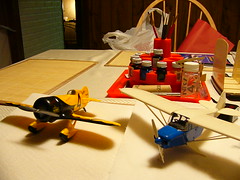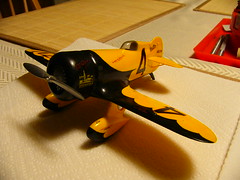My hands seemed to be steadier tonight, so I pulled out the model Tri-Pacer that I started a few months ago. I also unearthed another model that I found in the basement, a model racing plane that I had nearly finished from years ago - I must have set it aside sometime around 1992, when my former brother-in-law got me started with the bigger radio-controlled flying models. This poor kit only needed the last few scallops painted on its jaunty 1930s paint scheme, and a few odd parts glued on. I've dusted it off and hand-painted the last details, and with a coat of gloss enamel and a few flying wires it will be ready for the shelf.
It's a replica of the 1931 Gee Bee Model Z, a classic from the glory days of air racing. The Gee Bees (named for the New England company that built them, the Granville Brothers) were notorious for their approach to speed-seeking: maximum engine, minimum airplane. The stubby Model Z was only 15 feet long, but was bolted to a 535 h.p. "Wasp Junior" radial engine, loaned to the brothers by the Pratt & Whitney company for "testing". The combination was a handful to fly, but it was certainly fast; ex-barnstormer Lowell Bayles flew it to an easy win in the 1931 Thompson Trophy at 236 m.p.h.
But ambition seized the Granvilles and Pratt & Whitney, and the engine was changed out for an even bigger 750 h.p. Wasp Senior - in this form, Bayles could hardly see around the cowl! But an attempt was set up to try for the world speed record, 278 m.p.h., held by the French. The first set of straight-line runs averaged 281 m.p.h., good enough for the U.S. record, but not enough to better the world mark by a wide enough margin. The next time out, Bayles entered the timing run at over 300 m.p.h... but then cameras captured a gruesome sight as a wing panel snapped off, and the tiny Gee Bee rolled into the ground. Bayles and the plane were destroyed in an instant.
The Granvilles built other racers; their 1932 Model R won both the Thompson Trophy (with Jimmy Doolittle flying) and the transcontinental Bendix Trophy. But the whole family of planes were just like the Z, fast and capricious - and some less-experienced pilots were killed trying to pilot the "flying barrels" in other events. I've always been fascinated by them; the colorful scalloped paint schemes were a Granville Brothers trademark, and have come to be iconic of the whole pylon racing era. Many of these little planes were built in small hangars and garages during the Depression, with limited resources and engineering; but they contributed a lot to the advancement of aviation technology.

